Sansevieria Plant Care Guide
HOW TO GROW AND CARE FOR SANSEVIERIAS
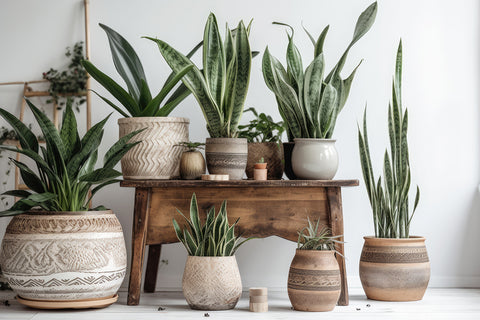
|
Common Varieties |
Sansevieria trifasciata (Snake Plant, Mother-in-Law's Tongue), Sansevieria cylindrica (African Spear Plant), Sansevieria masoniana (Mason's Congo), Sansevieria moonshine (Moonshine Snake Plant), Sansevieria laurentii (Variegated Snake Plant), Sansevieria zeylanica (Ceylon Bowstring Hemp), Sansevieria kirkii (Star Sansevieria), Sansevieria hahnii (Bird's Nest Sansevieria), Sansevieria francisii (Nairobi Viper), Sansevieria trifasciata 'Black Coral' (Black Coral Snake Plant), and Sansevieria trifasciata 'Golden Hahnii' (Golden Bird's Nest Snake Plant). |
|
Botanical Name |
Sansevieria spp. |
|
Family |
Asparagaceae |
|
Plant Type |
Perennial succulent |
|
Mature Size |
Varies by species and variety, but typically ranges from 30 centimetres to 120 centimetres in height. |
|
Light |
Sansevieria plants are adaptable and can thrive in a range of light conditions, from low light to bright, indirect light. |
|
Soil Type |
Well-draining succulent or cactus mix. |
|
Native Areas |
Various species are native to different regions in Africa and Asia. |
|
Toxicity |
Sansevieria plants are considered mildly toxic if ingested, and they can cause gastrointestinal discomfort in pets and humans. It's advisable to keep them out of reach of pets and children. Skin contact with the sap is usually not problematic but may cause minor irritation in some individuals. |
Sansevieria plants, also known as snake plants, are hardy and resilient plants native to tropical areas of Africa and Asia. They have a unique appearance with their long, pointed leaves, typically grey-green and sometimes edged in yellow. They are also known for their air-purifying capabilities, as they absorb toxins from the air and convert them into oxygen. Sansevieria plants are low-maintenance and can thrive in a variety of soil types. They are also extremely drought-tolerant and can survive for weeks without water. Sansevieria plants can make a great addition to any home, office, or outdoor space and provide a striking touch of greenery.
Our guide will provide all the information you need to keep your Sansevieria healthy and content, including tips on light and temperature needs, watering and fertilising, and how to propagate your plant. Let's embark on the journey of Sansevieria plant care together!
WELCOME TO YOUR COMPLETE GUIDE TO CARING FOR SANSEVIERIAS
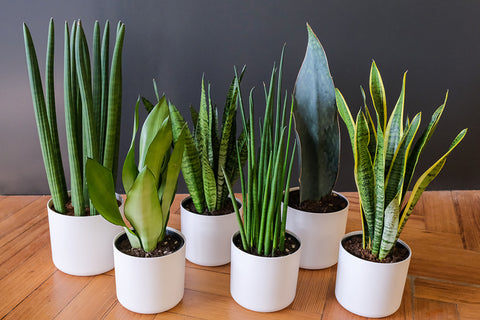
📷 Sansevieria, Chalet Boutique, Australia
HOW MUCH LIGHT DOES A SANSEVIERIA NEED?
Sansevieria plants need light to survive, but they don't need much. These plants do best in bright, indirect sunlight. They can also tolerate some direct sunlight, but too much can scorch their leaves. Give them at least 3-4 hours of bright, indirect light daily. If you can't provide enough natural sunlight, you may need to supplement your morning with a grow light. Sansevierias can also be grown in low-light situations, but they will not grow as quickly and may not flower.
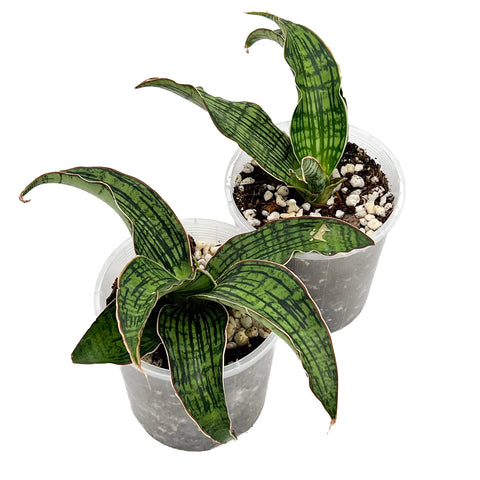
HOW OFTEN SHOULD I WATER A SANSEVIERIA?
Regarding watering, Sansevierias are quite drought-tolerant and prefer to be kept dry. During the summer months, water your Sansevieria every 3-4 weeks. During the winter months, reduce watering to every 4-6 weeks. Always check the soil before watering; only water if the top 3-5cm is dry. If the soil is still damp, it is best to wait until it is dry before watering.
WHAT IS THE BEST POTTING MEDIUM FOR SANSEVIERIA?
The best potting medium for Sansevieria is well-draining sandy soil. It should have a high proportion of perlite or other light and airy components, such as pumice or bark, to ensure adequate drainage. The soil should be slightly acidic, with a pH between 6.0 and 6.5. Additionally, the potting medium should contain plenty of organic matter, such as compost, peat, and worm castings. This will provide the plant with essential nutrients and help retain moisture. Sansevieria also appreciate extra sand or grit on top of the soil to help keep the plant's roots cool and prevent waterlogging.
WHAT IS THE BEST TEMPERATURE FOR SANSEVIERIA?
The best temperature for Sansevieria plants is around 18-24 degrees Celsius. It is essential to keep the temperature consistent as Sansevieria plants can suffer from too much heat or cold. Sansevieria plants generally are quite hardy and can tolerate temperatures as low as 10 degrees Celsius. However, keeping the temperature within the recommended range for optimal growth is best.
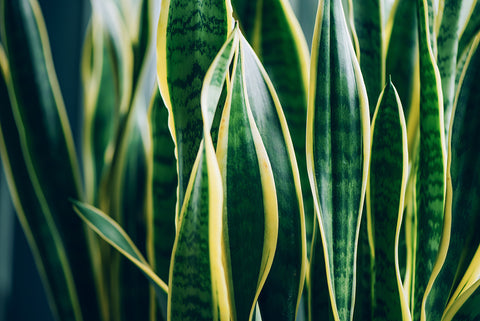
📷 Sansevieria trifasciata, Chalet Boutique
WHAT IS THE BEST HUMIDITY FOR SANSEVIERIA?
The best humidity for Sansevieria is 50-70% relative humidity. This can be achieved by placing plants in bathrooms, kitchens, and other areas with high humidity. Place a saucer filled with pebbles and water underneath the pot to maintain the humidity level. This will help to raise the humidity level around the plant. The ideal temperature for Sansevieria is between 18-24°C.
WHAT IS THE BEST FERTILISER FOR SANSEVIERIA?
We use Growth Technology, Foliage Focus for all our Sansevieria. 
The GT Focus range sets the benchmark for liquid nutrients. Here's why:
- Each GT Focus product is complete. Unlike the overwhelming majority of fertilisers, all Focus products contain each of the 12 essential minerals – including Calcium – blended into an easily absorbed liquid concentrate.
- pH buffered to ensure all 12 essential minerals are available to the plant.
- Formulated and balanced to suit the requirements of specific plant types.
- Manufactured using only the highest-grade raw materials and chelated trace elements to ensure effortless absorption by the plant.
- Guaranteed not to contain potentially harmful and ineffective chlorides, urea, sodium and ammonium.
- Easy to use with simple instructions.
- Makes up to 200 litres of working solution
WHAT ARE COMMON SANSEVIERIA PESTS, AND HOW YOU TREAT THEM?
Sansevieria can be susceptible to various pests, including aphids, mealybugs, spider mites, and scale insects. The use of beneficial insects such as ladybugs, lacewings, and parasitic wasps can be effective biological control against these pests.
Aphids are small, soft-bodied insects that feed on plant juices. They can be identified by their pear-shaped bodies, usually black, green, yellow, or brown. Aphids can weaken the plant by sucking out its sap, leading to yellowing and/or wilting leaves. Treatment for aphids includes spraying the plant with a strong water stream or using an insecticidal soap or neem oil solution.
Mealybugs are small, white, fuzzy insects that feed on plant sap. They are usually found in clusters on the underside of the leaves. Mealybugs can be treated with insecticidal soap, neem oil, or a cotton swab dipped in rubbing alcohol to wipe them off.
Scale insects are tiny, flat, oval-shaped pests that feed on plant sap. They can also be identified by the white, waxy coating they produce. Treatment for scale insects includes wiping them off with a cotton swab dipped in rubbing alcohol or spraying the plant with neem oil.
Spider mites are tiny, eight-legged arachnids that feed on plant sap. They cause yellowing and stippling of the leaves and webbing on the foliage. Treatment for spider mites includes spraying the plant with Kill-a-mite or Stealth. By monitoring these common pests and treating them promptly, you can ensure your plant stays healthy and thrives.
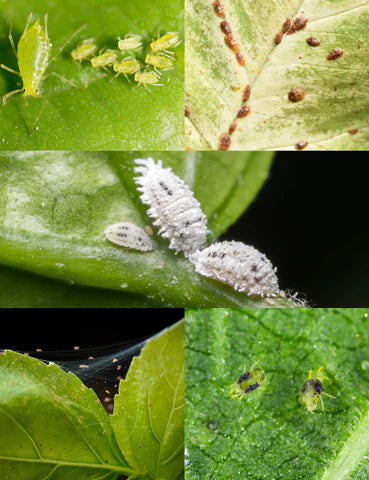
HOW TO PRUNE A SANSEVIERIA
Pruning a Sansevieria is a relatively easy task that can help keep your plant looking its best. The first step is to identify any leaves that have become yellow or brown and may need removal. To do this, carefully examine the plant and use your fingers to gently feel around the base of each leaf. Once you find a leaf that is either yellow or brown, use a pair of sharp pruning shears and snip it off just above the base of the leaf. Leave a small stub of the leaf so the plant can heal quickly. After you have removed any dead or damaged leaves, the next step is to trim any of the leaves that have grown too long. Again, use your fingers to feel the length of the leaves and use the pruning shears to trim off any leaves that have grown too long. Be careful not to cut too close to the base of the leaf, as this may cause damage to the plant. Once you have pruned the Sansevieria, it is essential to water it regularly and provide plenty of light to help it heal and grow. Pruning your Sansevieria regularly can help keep it looking its best and can keep it healthy and thriving.
HOW TO PROPAGATE A SANSEVIERIA
Propagating a Sansevieria is a simple process that anyone can do. First, collect a healthy leaf cutting from the top of the mother plant. Use a clean, sharp knife to take the cutting with a clean cut. Once you have the cutting, let it sit and callous over for a few days to allow the cut area to dry. After the calloused cuttings have formed, fill a pot or container with a light, well-draining soil mix and carefully press the cutting into the soil. Pack the soil firmly around the cutting to ensure good contact with the soil. Water the soil and place the container in a warm, bright area. Keep the soil moist but not wet, and wait for new roots and leaves to form. Repot the new Sansevieria when the roots have begun to develop.
WHEN DO YOU NEED TO REPOT A SANSEVIERIA?
When it comes to repotting your Sansevieria, timing is everything. It is best to repot your Sansevieria every two to three years or when the roots become overcrowded, and the plant starts to outgrow its pot. You will know it is time to repot when the plant gets top-heavy and the soil dries quickly. You can also check for root rot, indicating that the plant needs a larger pot and new soil. When repotting, make sure to use a container that is only one size larger than the previous one and use a well-draining soil mix to ensure proper drainage. Repotting your Sansevieria in the spring or summer is best, as it will help the plant to adjust to its new environment and get off to a strong start.
WHAT SORT OF POT DOES SANSEVIERIA NEED?
Sansevieria is a resilient houseplant that thrives with minimal care and attention. They prefer to be planted in a pot with well-draining soil, such as a lightweight soil mix, and plenty of drainage holes. The pot should be large enough to accommodate the plant's root system without being cramped. They do well in glazed ceramic containers, plastic pots, and hanging baskets. They can also be grown in shallow dishes, but water them more frequently. When choosing a pot for sansevieria, it is important to ensure that it is deep enough to allow the roots to spread out and grow.
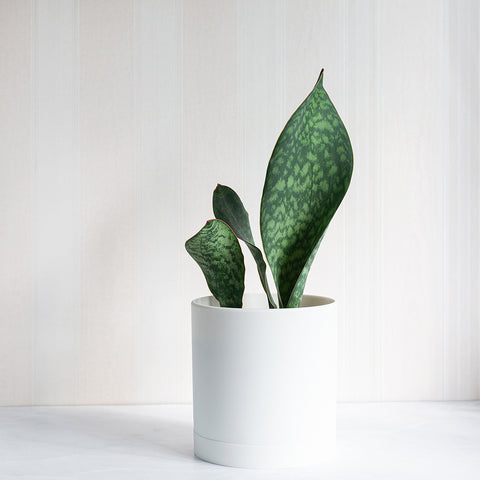
📷 Sansevieria Masoniana 'Whale Fin', Chalet Boutique
IS SANSEVIERIA TOXIC TO PETS AND CHILDREN?
Sansevierias, or snake plants, are popular houseplants for their easy care and attractive foliage. However, knowing they can be toxic to pets and children is essential. The plant contains saponins, which can be harmful if ingested and cause vomiting and diarrhea in cats and dogs. In addition, the plant can cause skin irritation when touched, so it is crucial to keep it away from children. If you own a pet or plan to have children in your home, it is best to avoid this plant.
A LIST OF SANSEVIERIA PLANTS
- Sansevieria trifasciata (Snake Plant)
- Sansevieria cylindrica (African Spear Plant)
- Sansevieria laurentii (Variegated Snake Plant)
- Sansevieria zeylanica (Ceylon Bowstring Hemp)
- Sansevieria hahnii (Bird's Nest Sansevieria)
- Sansevieria trifasciata 'Black Coral' (Black Coral Snake Plant)
- Sansevieria trifasciata 'Golden Hahnii' (Golden Bird's Nest Snake Plant)
- Sansevieria moonshine (Moonshine Snake Plant)
- Sansevieria trifasciata 'Futura Superba' (Superba Snake Plant)
- Sansevieria trifasciata 'Bantel's Sensation' (Bantel's Sensation Snake Plant)
- Sansevieria trifasciata 'Robusta' (Robusta Snake Plant)
- Sansevieria trifasciata 'Silver Hahnii' (Silver Bird's Nest Snake Plant)
- Sansevieria kirkii (Star Sansevieria)
- Sansevieria masoniana (Mason's Congo)
- Sansevieria francisii (Nairobi Viper)
